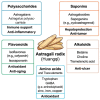Recent Advances in the Mechanisms and Applications of Astragalus Polysaccharides in Liver Cancer Treatment: An Overview
- PMID: 40649307
- PMCID: PMC12250682
- DOI: 10.3390/molecules30132792
Recent Advances in the Mechanisms and Applications of Astragalus Polysaccharides in Liver Cancer Treatment: An Overview
Abstract
Astragalus polysaccharides (APS), bioactive compounds derived from Astragalus membranaceus, have emerged as promising natural agents in the treatment of hepatocellular carcinoma, a leading cause of cancer-related mortality. Preclinical studies indicate that APS exerts significant anti-liver cancer effects through multiple biological actions, including the promotion of apoptosis, inhibition of proliferation, suppression of epithelial-mesenchymal transition, regulation of autophagy, and modulation of immune responses. These therapeutic effects are closely associated with the regulation of critical signalling pathways, such as PI3K/AKT/mTOR, Wnt/β-catenin, JAK/STAT, and TGF-β/Smad. APS also reshapes the tumour microenvironment by enhancing macrophage activity, reducing the regulatory T cell function, and improving host immune response. In addition, APS exhibits synergistic effects when combined with conventional chemotherapeutics and interventional treatments such as transarterial chemoembolisation, improving efficacy and reducing toxicity. Despite the robust experimental evidence, limitations such as low bioavailability and a lack of large-scale clinical trials remain challenges for clinical translation. This review summarises the recent advances in understanding the anti-hepatocellular carcinoma activities of APS, their molecular targets and potential applications, aiming to provide a scientific basis for future studies and the development of APS-based therapeutic strategies.
Keywords: Astragalus polysaccharides; PI3K/AKT/mTOR; anti-liver cancer mechanisms; apoptosis; applications of Astragalus polysaccharides; immunomodulation; liver cancer; signalling pathways; traditional Chinese medicine.
Conflict of interest statement
The authors declare no conflicts of interest.
Figures











Similar articles
-
Synergistic gut microbiome-mediated degradation of Astragalus membranaceus polysaccharides and Codonopsis pilosula polysaccharides into butyric acid: a metatranscriptomic analysis.Microbiol Spectr. 2025 Jul;13(7):e0303924. doi: 10.1128/spectrum.03039-24. Epub 2025 May 27. Microbiol Spectr. 2025. PMID: 40422281 Free PMC article.
-
Research Progress in the Medicine-Food Dual Use of Astragalus for Gastrointestinal Tumors.J Med Food. 2024 Dec;27(12):1145-1157. doi: 10.1089/jmf.2024.k.0057. Epub 2024 Oct 21. J Med Food. 2024. PMID: 39431943 Review.
-
Integrated transcriptomics and metabolomics studies reveal the therapeutic effects of Astragalus polysaccharides on cancer cachexia muscle atrophy.Sci Rep. 2025 Jul 19;15(1):26224. doi: 10.1038/s41598-025-11342-x. Sci Rep. 2025. PMID: 40684040 Free PMC article.
-
Structural characterization and anti-tumor immunomodulatory effects of polysaccharides from Astragalus mongholicus with different cultivation modes.Int J Biol Macromol. 2025 Jul;318(Pt 4):145233. doi: 10.1016/j.ijbiomac.2025.145233. Epub 2025 Jun 17. Int J Biol Macromol. 2025. PMID: 40516740
-
External beam radiotherapy for unresectable hepatocellular carcinoma.Cochrane Database Syst Rev. 2017 Mar 7;3(3):CD011314. doi: 10.1002/14651858.CD011314.pub2. Cochrane Database Syst Rev. 2017. PMID: 28267205 Free PMC article.
References
Publication types
MeSH terms
Substances
Grants and funding
- PL2024H002/Heilongjiang Province "double first-class" discipline collaborative innovation achievement project
- LJGXCG2023-089/Heilongjiang Province "double first-class" discipline collaborative innovation achievement project
- 2024-KYYWF-0617/Heilongjiang Province Education Department's Innovation Team
- JMSUGPZR2210/Jiamusi University's National Natural Science Foundation Cultivation Project
LinkOut - more resources
Full Text Sources
Medical
Miscellaneous

